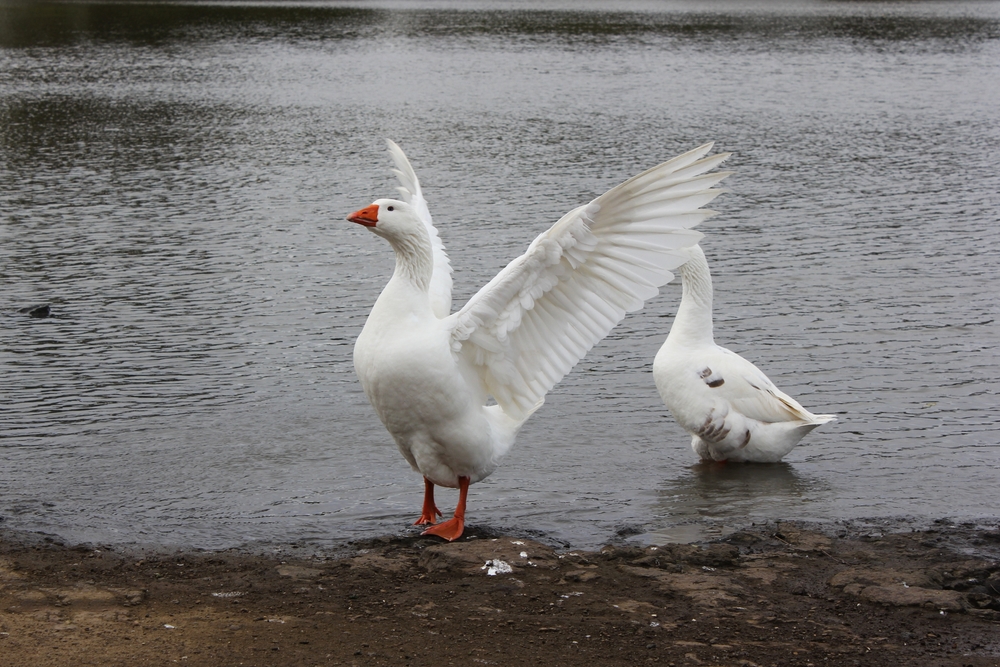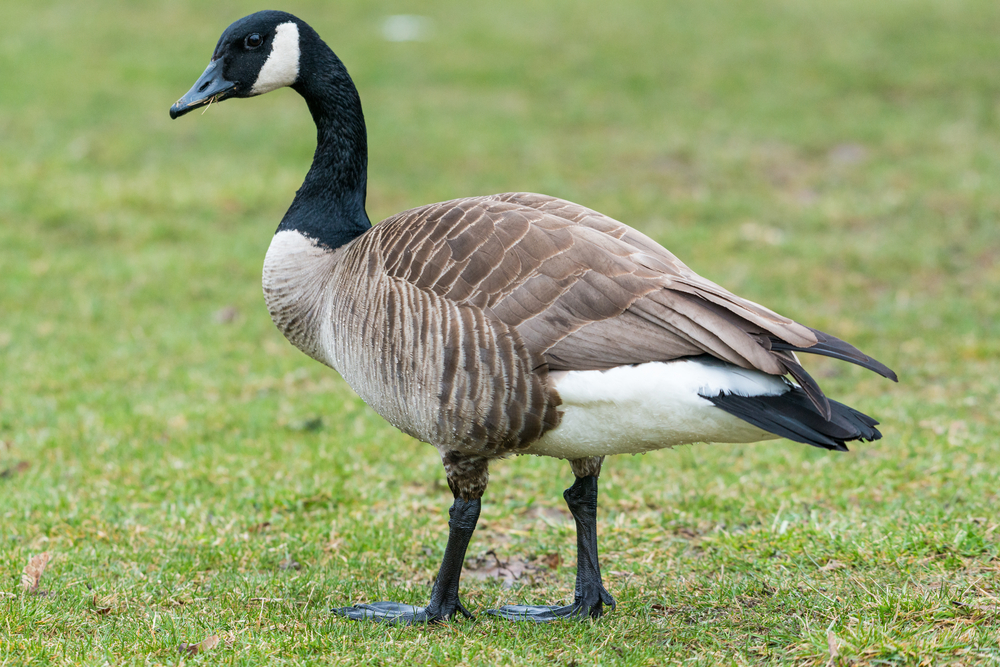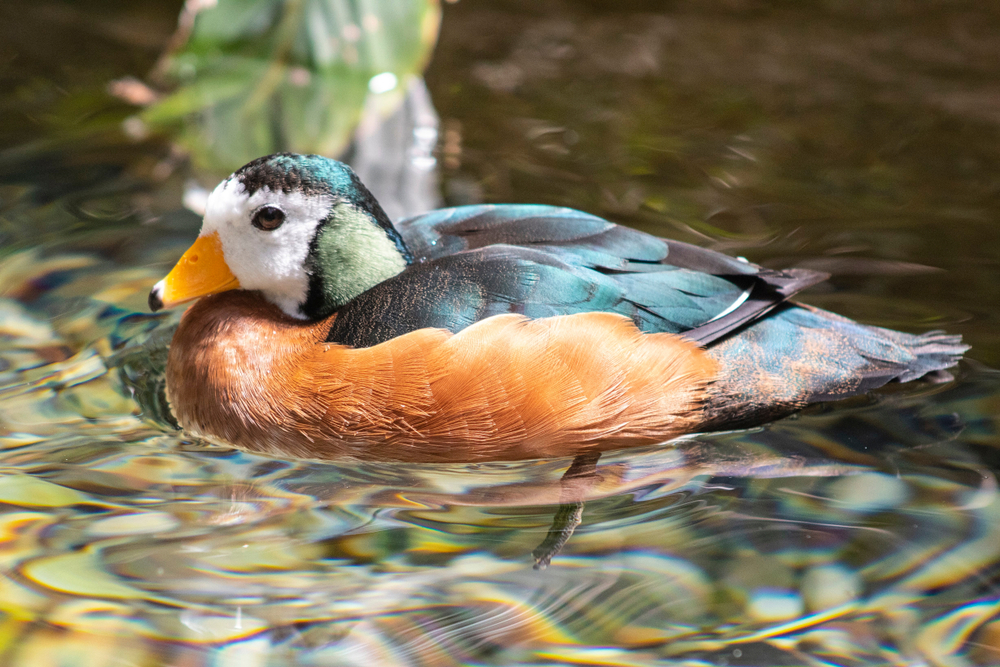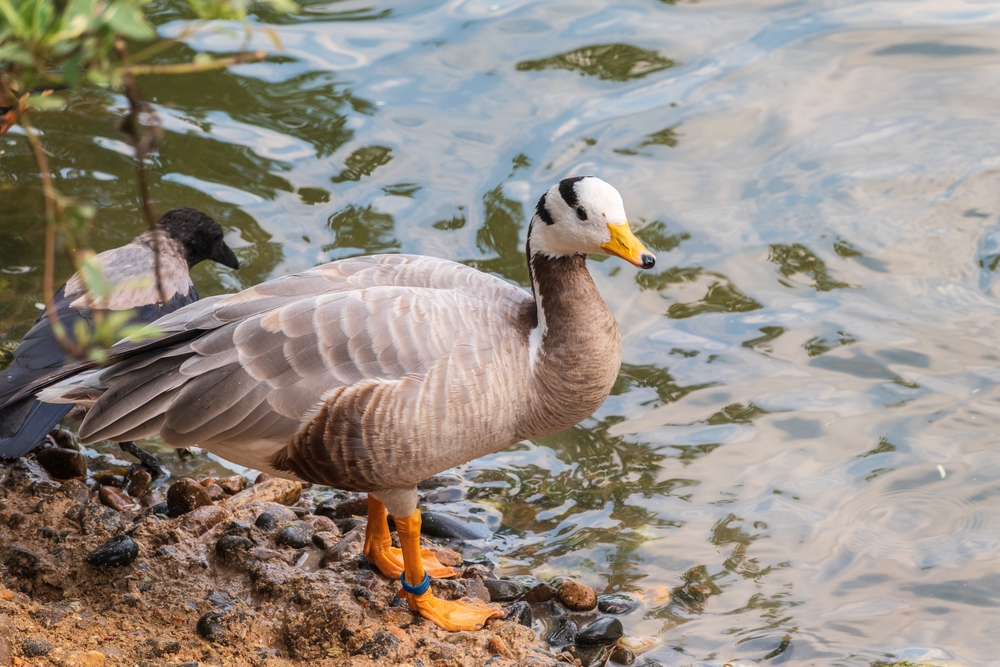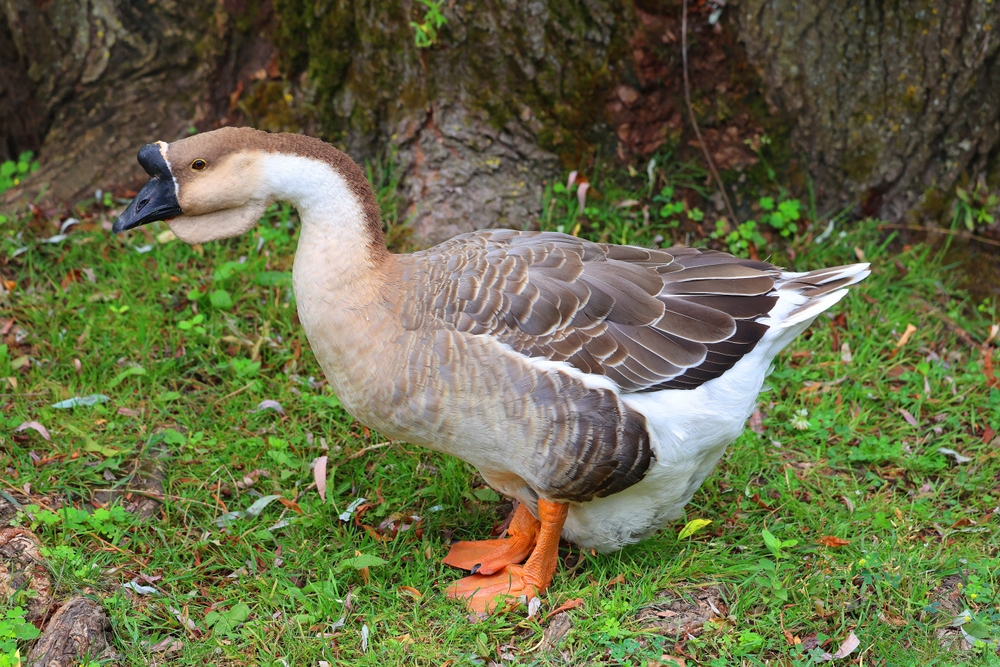The Domestic White Goose is descended from the Greylag Goose (Anser anser), making that species its closest wild relative. Some domestic breeds also show influence from the Swan Goose (Anser cygnoides), but the White Goose traces directly to the Greylag.
About
The Domestic White Goose (Anser anser domesticus) is a popular domestic breed belonging to the Anatidae family, which includes geese, ducks, and swans. Descended from the wild Greylag Goose (Anser anser), this breed has been selectively bred for centuries for meat, eggs, feathers, and as farmyard guardians. Its all-white plumage, bright orange bill, and orange legs give it a classic, elegant appearance that has become the image of the “traditional farm goose” worldwide.
Domestic White Geese are large birds, with ganders often weighing 8 to 10 kilograms (18 to 22 pounds) and females slightly smaller. Their snowy feathers not only make them visually striking but also valuable for down and feather production. They are hardy, adaptable, and thrive in a variety of climates when provided with ample pasture and water access.
These geese are primarily herbivores, grazing on grasses, weeds, and grains. They are excellent natural weed controllers, often used in orchards and fields to keep vegetation in check. Their loud, honking calls and protective nature make them effective farmyard “watchdogs,” as they will sound the alarm at intruders.
Domestic White Geese are seasonal layers, producing around 20 to 40 large white eggs each year, primarily in spring. They are attentive parents, with strong pair bonds and protective instincts toward their goslings. With proper care, they can live 15 to 20 years, making them long-term farm companions.
Widely kept across the globe, the Domestic White Goose symbolizes simplicity, abundance, and rural tradition. Whether raised for practical purposes or as ornamental birds, they continue to play an important role in agriculture and homesteads.
Physical Characteristics
The Domestic White Goose is a large, heavy-bodied waterfowl breed developed from the Greylag Goose (Anser anser), recognizable for its uniform snowy-white plumage and robust frame.
Plumage: As its name suggests, the Domestic White Goose has entirely pure white feathers, lacking the mottled browns and grays of its wild ancestor. The plumage is dense and insulating, suited for both cold and wet conditions.
Head & Beak: The head is broad with a stout orange bill that may show a small basal knob in some strains. The eyes are bright blue, framed by white plumage, giving a striking contrast.
Body & Neck: The body is deep-breasted and elongated, carried low and heavy on short, sturdy legs. The long, arched neck is graceful but thicker than that of wild geese. Legs and feet are bright orange and webbed for swimming.
Size:
-
Length (Body and Tail): 30–36 in (76–91 cm)
-
Wingspan: 4.5–5.5 ft (1.4–1.7 m)
-
Tail Length: 6–8 in (15–20 cm)
Weight:
-
Adult Male (Gander): 20–26 lbs (9–12 kg)
-
Adult Female (Goose): 16–20 lbs (7–9 kg)
The Domestic White Goose’s uniform white plumage, massive size, and bright orange beak and legs distinguish it from wild geese, making it one of the most familiar and widely kept breeds for farming, companionship, and ornamental use.
Reproduction
The reproductive cycle of the Domestic White Goose has been shaped by centuries of selective breeding, resulting in higher egg production and reliable parental care compared to its wild ancestor, the Greylag Goose.
1. Mating and Courtship:
Domestic White Geese are generally monogamous, though in farm settings, one gander may bond with multiple females. Courtship includes honking, head bobbing, and mutual displays. Ganders are protective and often aggressive toward intruders during breeding.
2. Breeding Season:
In temperate regions, breeding begins in late winter to early spring (February–April), though under managed care, some flocks may breed for longer periods.
3. Nesting:
The female builds a nest on the ground in a sheltered corner, using straw, grasses, and down plucked from her breast. Farmers often provide nest boxes for protection and easier management.
4. Egg Laying and Incubation:
A typical clutch consists of 10–20 large white eggs, depending on the strain and care provided. Incubation lasts about 28–35 days, performed by the female, while the male guards the area.
5. Hatching and Gosling Development:
Goslings hatch covered in yellow down and are precocial, walking and following their mother within a day. They weigh about 3–4 oz (85–110 g) at hatching and are led to graze on tender grasses almost immediately.
6. Growth and Fledging:
Young geese grow rapidly, feathering out by 8–10 weeks and becoming independent by 12–14 weeks. Selective breeding has enhanced fast growth for meat production.
7. Sexual Maturity:
Domestic White Geese reach breeding age at about 2 years, though some may start laying earlier under favorable conditions.
The Domestic White Goose’s high clutch size, dependable brood care, and adaptability to farm management make it one of the most productive and widely kept domestic goose breeds.
Lifespan
The Domestic White Goose is a hardy and long-lived farm bird, with its survival depending heavily on care, diet, and protection from predators.
Lifespan in the Wild (Ancestor – Greylag Goose):
The wild Greylag Goose (Anser anser), from which the domestic breed descends, typically lives 10–15 years, though some reach up to 20 years in the absence of hunting or predation.
Lifespan in Domestication:
Domestic White Geese usually live 15–20 years with good management. Under excellent conditions with balanced nutrition and veterinary care, individuals may live up to 25–30 years, although geese raised primarily for meat production rarely reach their full natural lifespan.
Threats to the Domestic White Goose:
-
Predation: Vulnerable to foxes, coyotes, raccoons, raptors, and stray dogs.
-
Health Issues: Obesity, bumblefoot, and reproductive strain in heavy-laying females can shorten life expectancy.
-
Environment: Poor housing, inadequate water access, and exposure to extreme weather can reduce survival.
-
Human Use: Many domestic geese are culled for meat between 3–12 months of age, far before their natural lifespan.
Conservation and Care:
As a domestic breed, its longevity depends on secure enclosures, access to clean water, proper diet, and regular health monitoring. When well cared for, they can live for decades and often become loyal farm or household companions.
Eating Habits
The Domestic White Goose is primarily a grazer, with feeding habits that reflect its origins from the Greylag Goose, though selective breeding and farming practices have shaped its diet.
Diet:
They consume mainly grasses, clover, weeds, aquatic plants, and grains. Farmers often supplement their diet with corn, wheat, barley, formulated waterfowl pellets, and kitchen greens. Vegetables such as lettuce, spinach, and cabbage are readily eaten.
Foraging Strategy:
Domestic White Geese are efficient grazers, spending hours cropping grass in pastures. Their broad, strong bills are designed for shredding vegetation. Access to grassy fields reduces feed costs and provides natural exercise.
Feeding Behavior:
They are social feeders, often grazing side by side in groups. They require constant access to clean water, both for drinking and for cleaning their bills while eating.
Human Feeding Practices:
On farms, they are usually provided with grain mixtures, cracked corn, or commercial waterfowl feeds. Overfeeding grains, however, can lead to obesity, which is common in heavier domestic breeds.
Seasonal Feeding:
-
Spring and Summer: Fresh grasses and weeds are the main diet.
-
Fall and Winter: Farmers supplement with stored grains, hay, and root vegetables.
Ecological and Practical Role:
Because of their natural grazing habits, Domestic White Geese are often employed as “weed control” birds in orchards and fields, reducing the need for herbicides.
The Domestic White Goose’s adaptable diet, grazing efficiency, and usefulness in farm management make it both practical for agriculture and easy to maintain in a wide range of environments.
Uniqueness
The Domestic White Goose is one of the most recognizable and iconic farmyard birds, distinct from its wild relatives in both appearance and role:
Pure White Plumage: Unlike the gray-brown feathers of its ancestor, the Greylag Goose, the Domestic White Goose has uniform snowy-white plumage, making it visually striking and popular for ornamental purposes.
Large Body Size: Selective breeding has produced geese that are larger and heavier than their wild counterparts, with ganders often exceeding 20 lbs (9 kg). This makes them highly valued for meat production.
Bright Orange Features: Their orange beaks, legs, and feet provide a vivid contrast to their white feathers, contributing to their classic farmyard look.
Farm Guardians: Domestic White Geese are famously alert and noisy, serving as natural “watchdogs”. Their loud honking warns of strangers or predators, a trait valued by farmers for centuries.
Adaptability: They thrive in a wide range of environments, from small homesteads to large farms, and are equally suited as utility birds or ornamental animals.
Cultural Symbolism: White geese have long held symbolic importance in folklore and tradition, representing loyalty, vigilance, and abundance. In Roman history, sacred geese were said to have saved the city by warning of intruders.
Versatility: They are a dual-purpose breed, prized for both their meat and their ability to lay large, nutrient-rich eggs, with some strains producing up to 40–60 eggs per year.
The Domestic White Goose’s combination of size, pure white beauty, usefulness, and cultural legacy makes it one of the most distinctive and celebrated domestic goose breeds.
Be the First to Share Photos of This Species.
FAQ’s
1. What is the closest species to the Domestic White Goose?
2. How does the Domestic White Goose compare to other geese?
It is larger, heavier, and whiter than wild geese, often exceeding 20 lbs (9 kg). Unlike migratory wild species, it is fully domesticated, bred for meat, eggs, and as a farm guardian. Its snowy plumage, orange bill, and upright stance make it instantly recognizable compared to gray, barred, or patterned wild geese.
3. What farms or settings provide the best opportunities to see a Domestic White Goose?
What farms or settings provide the best opportunities to see a Domestic White Goose?
-
Family farms and homesteads, where they serve as both utility birds and natural alarm systems.
-
Agricultural settings, particularly in Europe and North America, where they are raised for meat and egg production.
-
Ornamental ponds and estates, where their striking white appearance makes them popular decorative birds.
-
Heritage poultry shows, where they are displayed for their conformation and breed standards.



































































